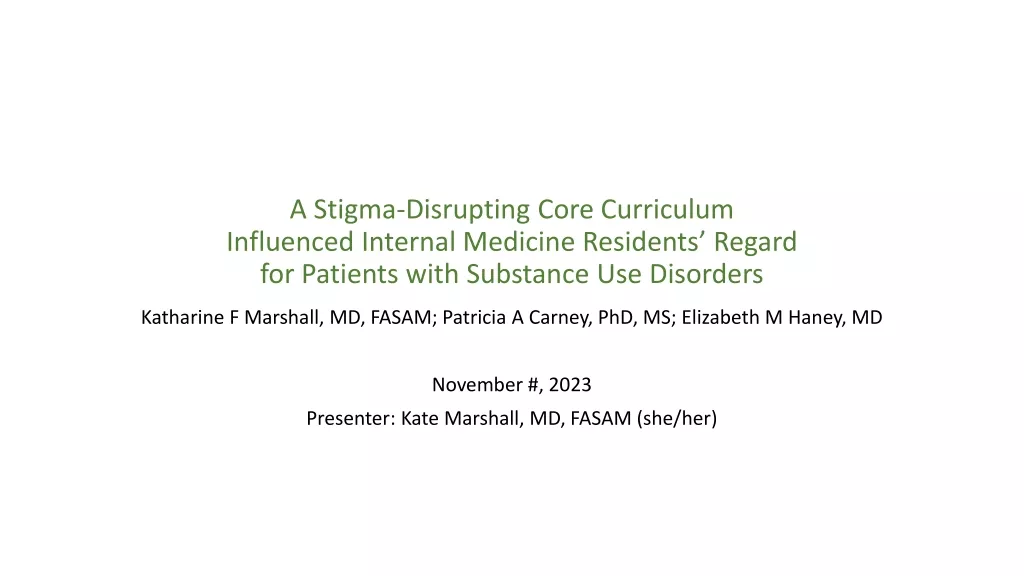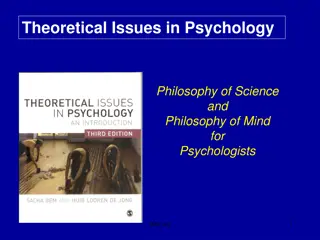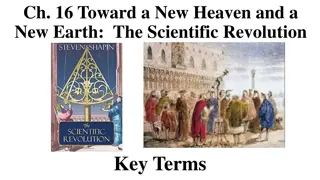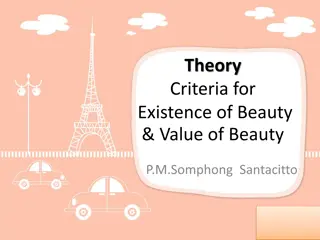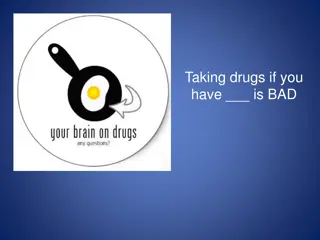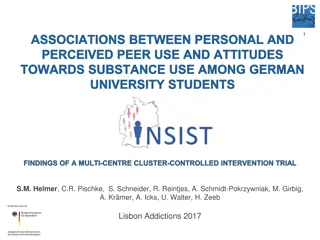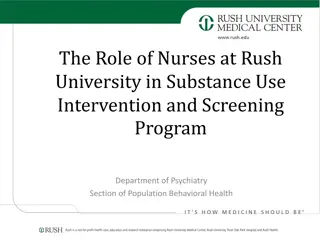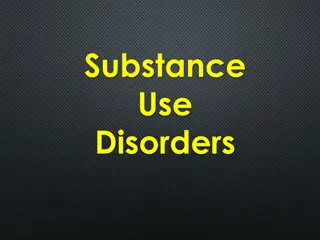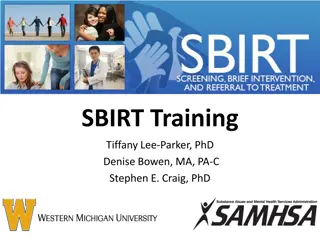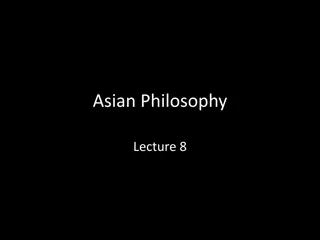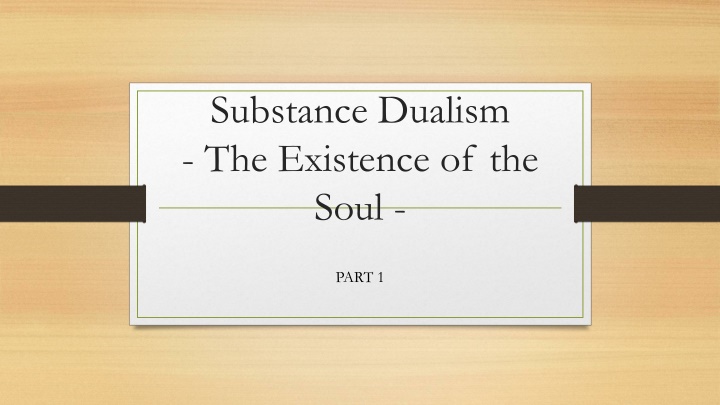
Substance Dualism and the Mind-Body Problem in Philosophy of Mind
Explore the intricate debate of substance dualism and the Mind-Body Problem in the Philosophy of Mind field. Delve into the nature of human consciousness and the existence of the soul, examining differing perspectives such as Physicalism and Substance Dualism. Discover the traditional Christian interpretation of the soul's composition, encompassing both physical and non-physical components. Engage with the complexity of these philosophical concepts through accessible explanation and analysis.
Download Presentation

Please find below an Image/Link to download the presentation.
The content on the website is provided AS IS for your information and personal use only. It may not be sold, licensed, or shared on other websites without obtaining consent from the author. If you encounter any issues during the download, it is possible that the publisher has removed the file from their server.
You are allowed to download the files provided on this website for personal or commercial use, subject to the condition that they are used lawfully. All files are the property of their respective owners.
The content on the website is provided AS IS for your information and personal use only. It may not be sold, licensed, or shared on other websites without obtaining consent from the author.
E N D
Presentation Transcript
Substance Dualism - The Existence of the Soul - PART 1
Introduction 2ndpoint: This study pertains to a field in academia known as the Philosophy of Mind and in particular we shall be addressing an aspect within this field of study known as the Mind-Body Problem . This field can involve quite technical jargon and it is very complex at times, I will do my best to organize and explain all the relevant terminology and categories so that it is accessible to those unfamiliar with the debate. Unlike with the Shroud, where I completed over 10 Podcasts and was still counting, I will try to summarize all the relevant material of this subject matter in 4-6 Podcast lectures and 1 or 2 follow up discussions with Andrew, that will be a maximum of 6-8 bonus Podcasts on the issue of substance dualism/the soul; so you won t need as much sustained interest and mental endurance as I was demanding from listeners in my Shroud series
The Mind-Body Problem The Mind-Body Problem is principally concerned with the nature of human consciousness in relation to the human body and how they relate to one another. There are two fundamental aspects on which philosophers and other experts disagree; i) the first is on the nature of the various properties & states of consciousness, and ii) the second is on the nature of the subject/substance which bears the various properties and states of consciousness. In relation to the first issue of contention- the nature of conscious properties and states, there are 3 major categories a person can take with regard to how they see them; i) Physicalism- the position there are only physical properties and states (there are various versions of this option), ii) Mere-Property Dualism (usually associated with some sort of emergentism and entails 2 different types of properties/states) and iii) Property Dualism Simpliciter (also supposes 2 different types of properties/states). *** We will discuss these in more detail later on in this series. On the second issue of contention- the nature of the substance of consciousness, there are only 2 major categories to choose from (each with multiple versions under each category); i) Physicalism- the position there is only one substance or subject of consciousness regardless of whether there are different types of properties/states or not and ii) Substance Dualism (the notion that human consciousness not only entails dual properties/states but also entails two different substances- one physical (i.e. the brain/body) and another non-physical in nature.
Traditional Christian Interpretation In this series, I will be advocating for the traditional Christian interpretation of how to answer these two aspects of the Mind-Body Problem . As such, the first thing to do is to lay out and explain what the traditional Christian understanding of human consciousness entails. Both the Bible and Christian church tradition have always maintained that certain properties/states of affairs in humans are non-physical in nature and that the human being as a substance, is composed of both a material/physical component (the body) and an immaterial/non-physical component (the soul)- the latter of which is capable of surviving independently from the physical body (Eccles 12:7, Matt 10:28, Gen 35:18, 1 Kings 17:21-22, Luke 23:46, 2 Cor 5:1-10, Phil 1:21-24 & Heb 12:23) (New Phil Found- p.208-209). Furthermore, animals are living creatures and thus have souls like humans- albeit their souls are said to be different than human souls to varying degrees (Gen 1:30, Rev 8:9).
The Christian Conception of the Human Soul On the second issue of contention about the subject of consciousness; Christians advocate for what s called the substance dualism position (this position necessarily implies they take a Property Dualism Simpliciter position on the first issue of mental properties/states as well)- thus, humans are claimed to be composed of physical/material and immaterial/spiritual (and/or mental) substances which are privy to non-physical mental/spiritual properties/states. In the first place, it is important to note that there are a variety of terms used by Christians to describe human consciousness, each of which can be argued to have different meanings. There is the concept of the mind, the soul and the spirit all of which seem to be differentiated from each other in Scripture, while in other cases they can be seen to be relatively synonymous. For our purposes in this series, we will assume they are synonymous unless otherwise stated. So what might it mean to have a soul/spirit or mind within a Christian context?
The Human Soul Explained The human soul is a spiritual substance that is fully present in the body in the same way that God is said to be fully present in the universe (i.e. they are cognizant of and causally active at every point in the body/universe). Furthermore, the soul is a complex substantial, unified reality that is subject to various spiritual/mental properties, states of affairs and relations which inform/interact with a physical human body & vice-versa. Hence, the human soul and body stand in cause-effect relations with each other (for example if I a worry this will cause my brain chemistry to change or if my body is pricked with a pin, it will cause my soul to have the mental/spiritual sensation of being in pain)- this relationship between the body and soul is typically known as Substance-Dualism Interactionism . Thus the human persons are said to be holistic functional unities as exemplified via their souls.
Structure of the Soul Human souls consist of an intricate structure involving various mental/spiritual states and faculties. States of the soul refer to various states of affairs within the soul whereby a certain capacity/capacities are actualized or utilized (either consciously or subconsciously). In the same way that water can be said to be in a hot vs. old state there are various ways a soul can be said to be in one state or another at a given time.
States of the Mind/Soul There are 5 different states of the soul that a human can experience (none of which are considered to be physical states); i) Sensations- a mode of consciousness whereby one has a non-propositional and non-appetitive passive (passive in the sense that they happen to the subject) experience typically related to one of the 5 senses. For example, having a pain sensation or the sensation of seeing red , etc. (See Evolution of Soul book by Swinburne, p.21-22). ii) Thoughts- mental propositional content conveying information that can be expressed in a sentence and that only exists in the mind/soul as it is being consciously thought about. (Swinburen Evolution book, Ch on thoughts or definition here from New Phil Found book, p.274). iii) Beliefs iv) Desires v) Volitions/Acts of Freewill.
Faculties of the Soul Faculties of the soul refer to various capacities or potentialities that could become actualized given certain conditions. The soul has a multitudes of capacities all of which can be categorized into various related types of faculties and capacities such as the capacity to see red belong to the sight capacity (with the sight capacity being a part of the senses faculty) or thinking about math falls within the thinking capacity category (which falls under the faculty of the mind ). While not unanimous, the majority Christian understanding of the human mind and spirit is that they are both separate faculties of the human soul. The mind faculty pertains to our thoughts and beliefs and our ability to have them whereas volition and desires may pertain to our will faculty- but various faculties can overlap and interact with each other simultaneously). The spirit faculty pertains to the part of the soul that allows a person to relate to God specifically (Hebrews 4:12 says soul is separate of spirit- Word of God can separate them).
Human vs. Animal Souls It may be surprising for some of you to learn that biblically speaking animals also have a spirit and soul just like humans. In the OT the Hebrew nepes (soul) and ruah (spirit) are both used of animals in Gen 1:30 & Eccles 3:21 respectively and in the NT the Greek word for soul psyche is used of animals in Rev 8:9. Animals obviously are conscious beings with emotions, sensations, thoughts, desires and beliefs. Obviously, we don t have access directly to the internal mental states and faculties of animals and thus all we can do is reason via the philosophical Principle of Charity . For example, dogs experience pain sensations because they grimace or yelp when stuck with a pin just like humans grimace and scream Ouch! when in pain. Reasoning in this way, we can infer that different animals have differing soul capabilities/faculties based on how similar or different their behaviours mimic human behaviours in certain circumstances. For example, it is more questionable whether worms feel pain or not compared to dogs and thus, it seems there may be degrees of consciousness in the animal kingdom. Thus there depending on the animal, there are various similarities and differences regarding their souls compared to the human soul- we shall compare the more advanced animals here.
Animal Soul Similarities/Differences Similarities (New Phil Found Book, p.276); Animals can certainly have various sensations such as taste or sight or pain, etc. Animals can have various desires such as a desire for food. Animals can have thoughts and beliefs such as using mean-to-end reasoning if he desires food and the door he normally goes through to get is closed, they can seek other options to achieve their goal. Animals can have willings in the sense that they can will to do something (but this is not necessarily the same volitions which require libertarian freewill as an exercise of power to endeavour to do something- see differences below).
Animal Soul- Differences Differences (New Phil Found Book, p.276-277); 1. Animals do not have libertarian freedom of the will instead their wills seem to be determined by their beliefs, desires, sensations and bodily states. 2. Animals have no moral awareness nor do they grasp key conceptual notions of morality (such as moral duty, values/virtues or universalizing a moral judgement. 3. They cannot distinguish between what they desire most and what is most desirable intrinsically/inherently. 4. Altruistic behaviour is ascribed to base desire rather than on the basis of moral duty or intrinsic value. 5. Animals do not have conflicts between their desires and duties though they do experience a conflict of desires on occasion (ex. A desire to bite a chair vs. a desire not to be hit). 6. Animals do not exhibit the capability of having abstract complex thoughts such as thoughts about what love in general is or a concept of what truth is or even about what food in general is.
Differences cont. 7. Animals cannot distinguish between true universal judgements vs. mere statistical generalizations (all crocs are dangerous vs. most alligators are dangerous). 8. Animals only have first-order states of soul, they do not seem to have second-order states like humans who have desires about their desires, beliefs about their beliefs, etc. (for example I desire not to desire alcohol). 9. Finally animals seem not to possess language. Animals can be trained to recognize signs but don t seem to understand the use of symbols which are required for real language. The word banana is a symbol that represents and/or refers to actual bananas on a conceptual level whereas signs are merely sense-perceptible objects that through experience an animal can come to habitually associate it with the sense-perception of a real banana afterward, but the same result could be obtained using any sign whereas only certain symbols (like the word banana or picture of one) can represent a real banana using language. Differences Conclusion: Thus, while animals have souls, they are not as richly endowed as human souls are, they lack several faculties and capacities that humans have and hence why they are not considered to bear the image of God like us.
Different Versions of Substance Dualism Now, its important to note that not all substance dualists are the same- there are multiple versions of substance dualism with subtle variations of nuance to them and while all the arguments for and against the existence of the soul in this series apply equally to all such versions of substance dualism, it will be instructive to cover the three main versions of substance dualism to explain their differences. Another interesting note is that, despite the misleading appearances of the term and how I ve chosen to describe it earlier in this Podcast, substance dualists don t necessarily make the claim of a there being a dualism of two independent/separate substances (though some versions of Cartesian dualism do posit this), for our purposes in the rest of this series (unless mentioned otherwise) the term substance dualism will only minimally entail that there is an immaterial self/soul/mind/I and it is not identical to its material/physical body.- New Phil Found Book, p.264.
Substance Dualism #1- Thomistic/Aristotelian-like Dualism There are many variations or sub-versions of this theory of substance dualism and the one we will be explaining here is known as metaphysical Aristotelianism as advanced first in the late medieval period and modified more recently to be consistent with information theory and the intelligent design movement in modern biology. Proponents of this view include people from Thomas Aquinas in the medieval period to modern philosophers like Eleonore Stump, Peter Kreeft and J.P. Moreland. This view is based on Aristotle s notion of classical essentialism (which I referenced in regard to the ideal human nature and virtue ethics in Part1 show on Why are about the Bible blogs). In this view the body is actually seen to be a part of the soul itself as opposed to viewing the body as separate substance or bundle of physical properties and the soul in addition to having all the capacities for consciousness also enlivens, animates and teleologically develops its body. Hence under this view, the body is actually a mode of the soul itself (i.e. the soul can exists without the body but not vice-versa a body without the soul is a corpse).
Metaphysical Aristotelianism cont. The body is seen as a literal functional entity to the soul which combined is a holistic notion- thus this view supports a view which is growing in popularity in modern biology known as organicism (the organism as a hwole stands above its components and parts like DNA and dictates their behaviours/functions). The soul is holenmerically present at all points in the body simultaneously without spatial extension (just like an spatially unextended point in mathematics)- in the same way God is said to be present holenmerically at all spatial points in the universe. The biggest objection to this view is that it usually entails some sort of vitalism which has largely been falsified by modern science. Vitalism usually entails a spatially extended essential essence, force (as in a life force) or physical fluid like the outdated notions of caloric or phlogiston fluids, that exist in the body and function in the same way as other physical entities in the body on a mechanistic level. This has been falsified there is no such immaterial mechanistic entity within our bodies. A close analogy as to what this view entails is similar to how modern biologists and intelligent design proponents view information as a sui generis of irreducibly immaterial entity which teleogically guides and develops all physical entities of the body (including our DNA, proteins, RNA, etc.). In effect the soul, like information, can be seen as the master blueprint for the body.
Substance Dualism #2- Cartesian Dualism Cartesian Dualism has several different sub-versions which are closely-related which started with Rene Descartes (of I think, therefore I am fame) and has now been adapted by various contemporary philosophers such as Richard Swinburne, Stewart Goetz & Charles Taliaferro. Cartesian dualists principally differentiate themselves from Aristotelian/Thomist Dualists by reducing the soul to the mind which is said to be an immaterial substance that exemplifies pure consciousness or at least has the ultimate capacities needed for consciousness. But in this view the Mind/Soul is not said to animate or enliven the body like the Thomistic/Aristotelian notion of vitalism (see New Phil Found, p.265 & on Vitalism , see p.270). Descartes saw the body as a machine physical substance in itself whereas modern Cartesians tend to see the physical body as more of a physical property-thing or mereological aggregate - either way however, the body is viewed by Cartesians to be a purely physical object which is totally describable in physical terms- see, p.265.
Cartesian Dualism cont. The entire Mind-Body relationship is that of an external causal relationship. Two-way cause and effect interactions- will to raise my arm, body does it or stuck with a pin, I feel a pain sensation. As to spatial location of the soul/mind some claim the mind is not spatial in anyway, others hold that it it is located at some place in the body and finally others hold to the mind being holenmerically present in the body- meaning it is fully present to the body as a whole and fully present at each spatial point within the body s spatial boundaries (p.265). All the arguments we will present in favour of substance dualism support Cartesian Dualism, however there are 3 arguments against the truth of this notion of substance dualism.
3 Contra-Cartesian Arguments 1. The Causal-Pairing Problem: How do we pair a cause and effect together is Cartesian minds lack spatial features?- See the gun shooting Bob and Adam example on p.265. 4 Counters to this Problem; a) First it is question-begging and outright false to assert that spatial features are necessary conditions for causality and causal pairing as we can clearly conceive of possible worlds without space where causes can result in effects (modern cosmology and quantum indeterminacy agrees with me in establishing the conceivability of such a notion- slit experiments). b) Some experts have postulated that there may be a non-spatial metaphysical analogue to space- sort of a metaphysical grid of sorts that can provide a non- spatial location for each soul and this is sufficient to pair it with its corresponding physical body (Timothy O Connor has done a lot of work on this notion). c) The difference between general vs. singular causation; most physical causes are examples of general causation whereby the same causes will produce the same effects in all instances (such as smoking will cause lung cancer over time)- this akin to scientific laws of nature causation however, the interaction between a spaceless Cartesian mind and its body could be a case of singular causation whereby God created and designed a specific soul to interact only with a specific body- if so then there is nothing a skeptic can say to this counter apart from mindlessly dismissing it out of sheer skeptical bias. d) Finally, many Cartesians don t claim the mind is spaceless even if they do claim the mind/soul has no spatial extension they nonetheless claim it does have a spatial location at a specific spot in the body and/or is holenmerically present in its entire body which is spatially located.
Contra-Cartesian cont. 2. Against people saying it exists like an unextended mathematical point in specific place in body- where is it and why there (this is arbitrary) and if minds are subjet to spatial exclusion why not treat them as odd material objects? (This objection is dumb and can skip from my Podcast). Counters; a) No argument as to why the mind/soul can t be located at several points at once. Like triangularity we may not be able to imagine it but its perfectly intelligible and conceivable even if not imaginable by humans- p.266. b) Even if the mind or soul is located in one location only our inability to know where or why the one place is/was selected doesn t prove its not true- our cognitive finitude hinders us all the time. The Heisenberg Uncertainty principle proves we can know some things even if not all things about a particle- that doesn t mean particles don t exist. P.266-267. Same deal with why there and not elsewhere this is unanswerable or iterative (repeatable over and over again regardless) type question. And spiritual issimpler than physical entity so that s why not posit a weird physical ad hoc object.
Cont. 3. If the soul is a spatially located math point (unextended version), how could it have enough structure to do all the causal work attributed to it? Counters; Thoughts, desires, et have no spatial extension or relations- makes no sense to say my one desire is to the left of my thought, and to right of my red sensation, etc. Thus, this is a non-issue as complicated structures of mental properties and states do not require spatial extension in the same way. p.267. in New Phil Found book.
Substance Dualism #3- Haskerian Substance Dualism A more recent view that tries to be more in line with contemporary Atheistic scientists is William Hasker s view whereby when matter reaches a certain level of complexity, a new substance (the soul) emerges from the matter- thus this is a form of emergentism but postulates the emergence of a soul and not just mental/spiritual properties/states but an entire new substance. Hasker believes that the soul is spatially located and extended in the brain as well (unlike other versions of substance dualism which say the soul is not spatially extended). This view seems to be more agreeable to modern science as per experiments where people s corpus callosum connecting their two hemispheres are disconnected- this Hasker believes proves that the soul can be divided and create two separate souls/persons.
Hasker cont. Now this view is obviously false from a traditional Christian perspective. To counter the split brain experiment evidence we must remember that after the apparatus is removed the person goes back to being a united whole again, which doesn t make sense to say that doing so would eliminate a soul. (New Phil Found book, p.272). Thus, the switch model interpretation seems to make more sense, if Hasker, is correct- the soul alternates in rapid succession from hemisphere to hemisphere thereby preserving the unity of the phenomenal consciousness /soul but access consciousness is temporarily divided (New Phil Found book, p.272 & also definitions of the terms on p.214 & 216 respectively).
PART 1 CONCLUSION Alright that covers Part 1 on giving an introduction to the Mind-Body Problem and the traditional Christian understanding of the soul-body relationship known as substance dualism interactionism . Next time, we shall evaluate the first aspect of the mind-body problem on the nature of mental properties and states and provide some arguments that can prove that a dualist explanation is superior to a physicalist one in that regard. Thank you!
END OF PART 1 END OF PART 1 ON SUBSTANCE DUALISM general sources = https://www.closertotruth.com/topics/consciousness/mind-body-problems/the-mind-body- problem and see other related topics on souls, etc from the world s experts on this matter for all the videos on YouTube on all sorts of topics see here = https://www.youtube.com/watch?v=lpiMzVA6lDE .. Also JP moreland = https://www.youtube.com/watch?v=lpiMzVA6lDE . https://www.newdualism.org/papers/J.Moreland/Moreland-Soul_Matters.pdf (online book by JP Morleand). Aniamls vs. Humans = https://www.closertotruth.com/series/how-are-humans-unique & Cartesian dualism- Richard Swinburne = http://www.newdualism.org/papers/R.Swinburne/Dualism-Intact1996.htm & https://www.youtube.com/watch?v=sifzXoGv61Q . Also Swinburne vs. Tim O Conner who talks about the metaphysical grid to answer the objections against dualism= he also mentioned by JP Morleland on p.266 of NEW PHIL FOUND BOOK) both are Christians = https://www.youtube.com/watch?v=W0VfrSRSLo4 . There is a good online source to include on Thomistic/Artistotelian dualism here- website on article of DNA as information. = https://thomasaquinas.edu/pdfs/aquinas-review/2015.pdf (see p.67-96). By Thomas J. Kaiser. And Elenore Stump = https://www.youtube.com/watch?v=Fui2uBDP4Gs . & https://www.youtube.com/watch?v=Bbs47txouCE . William Hasker on Haskerian dualism = https://www.youtube.com/watch?v=XwUMBIlkRXk (has rebuttal from Stewart Goez who is a Cartesian dualist at 40 min mark approx) & https://www.youtube.com/watch?v=0hlkZOpdZIo (interview). ALSO THIS SKEPTIC S VIDEO MENIONS THE SPLIT-BRAIN EXPERIMENT = https://www.youtube.com/watch?v=RZTCK8ZluEc . DON T INLCUDE THIS IN PODCAST SOURCES = JP MORELAND IS A THOMIST NOT A CARTESIAN = http://www.jpmoreland.com/books/body-soul/ - Chapter 6 develops a view of the soul s relationship to the body. It is here that we especially part company with Cartesian dualism and advocate Thomistic dualism as both of those are frequently understood .
MORE SOURCES PART 1 Tim Oconner- Metaphtsical grid answer to Causal Pairing Problem against dualism = http://www.indiana.edu/~scotus/files/OConnorAgentCausalTheories.pdf (38 pages by him), https://kuscholarworks.ku.edu/bitstream/handle/1808/9509/auslegung.v26 .n01.069-076.pdf;sequence=1 & a video to include = https://www.youtube.com/watch?v=U0OU9uifs_M . Only give the video in my sources.
SUBSTANCE DUALISM SERIES - Part 2 - Hi Property Dualism argument Pro-Soul #1 argument which has three arguments under it.- list the different options first and escribe them and then give Pro-argument in New Phil Book (wait to give Contra arguments as they apply to both property dualism and substance dualism so save for the end). USE CLOSER TO TRUTH SOURNCES FOR ARGUMENT THAT ARE PRO-DUALSIM/SOUL LIKE THIS = https://www.youtube.com/watch?v=lpiMzVA6lDE (PLANTIGA- LAW OF IDNEITY- dependence is not same as identity- digession depends on brain function but not same or idneitcal to a brain function he says) AND ALSO RICHARD SWINBURNE, JO MORLEAND, STUMP, ETC. Now getting into the topic I really care about- explain mere property and property simple- are the same dualists on this and their difference is over substance so can combine into the dualist position of properties, etc. vs. physicalism- so Ken and everyone can be united against skeptics here.
SUBSTANCE DUALISM SERIES - Part 2 - Hello. In Part 2 of my series on the Existence of the Soul, we will be focused on the first major issue of contention of the Mind-Body Problem; what is the nature of consciousness in terms of its mental properties and states themselves. Here, we don t care about the question of the subject or substance of consciousness (the second issue of contention) and for the remainder of Part 2 we can remain neutral on this latter issue until Part 3. As you ll remember from Part 1- there are three main positions that one can take on the first issue of contention regarding mental properties and states; i) A Physicalist Position- whereby such properties and states are said to only be of a physical nature ii) Mere-Property Dualism- the notion that properties and states are dualist in nature but there is only one substance- the physical brain. iii) Property Dualism Simpliciter- both mental properties/states and the substance/subject of consciousness itself are dualistic (physical and non-physical substances).
The Physicalist Notion A Physicalist Position- whereby such properties and states are said to only be of a physical nature as listed in the Physics and Chemistry textbooks; these include properties like hardness, electrical or magnetic properties, malleability, elasticity or mass/density. Physicalists say that mental properties and states are identical to , as opposed to caused and/or constantly correlated/coincident with physical brain/body properties and states. There are various types of Physicalist interpretations of consciousness which can be classified into 1 of 2 major categories; i) Reductive and ii) Non-Reductive.
Pro-Property Dualism Arguments Getting straight into the main part of the Podcast, I want to present a couple arguments that support the notion that conscious properties and states/events are in fact mental/spiritual in nature and not physical in nature. Remember the essential issue of contention is related to the Logical Law of Identity- if entity x is identical to entity y then whatever is true and/or possibly true of x must be true of y and vice-versa. The identity relation is completely different from establishing a causal and/or constant conjoining/correlation relationships. So, for the sake of argument here one s mental properties could be entirely dependent on the physical brain to exist and this is not relevant in this Podcast.
Pro-Property Dualism Argument #1 Differences Argument: The first argument that dualists make is to demonstrate that there are some clear differences between conscious/mental and physical properties and states/events. If true, then the logical law of identity dictates that consciousness cannot be physical in nature. Dualists point to 5 features that differentiate mental states from physical ones; A) There is a certain raw qualitative feel of what-it-is-like to be having a mental state that doesn t obtain to physical states (aka. qualia ). B) Various mental states have intentionality (an ofness or aboutness ) directed toward a given object. C) They are inner, private and immediate to the subject having them. (PINK ELEPHANT EXAMPLE HERE) D) They are necessarily owned by the sentient subject having them. E) They fail to exhibit crucial physical features such as spatial extension or being composed of divisible parts like a neuron and cannot be described adequately using physical language (usually being defined ostensively - p.213 for word). Ex- no sense to say thought of john is to the left of desire for ice cream or thought of Jack.
Argument 1- Differences of Properties/States A) & C) We are all aware of what s called our phenomenal consciousness whereby various phenomenal properties called qualia (or mental states) present themselves directly to us- it refers to the raw what-it-is-like aspect of being in pain or thinking about Trump- there are discernible differences in the what-it-is-like-ness of the various qualia which are recognized immediately through private introspection. Qualia exhibit what is called epistemic subjectivity which entails three various aspects 1. Our consciousnesses have direct access to such properties and states- this is sometimes referred to as their being self-presenting properties , meaning they are psychological attributes that are immediately and directly present to a subject s field of consciousness. By contrast, physical properties and states are not self-presenting to our consciousness in this way but instead we can only become aware of them via indirect means
Argument #1- Self-Presenting Properties Argument Premises In premise format one could phrase the argument this way; Premise #1 No physical properties are self-presenting (no direct access to them) & Premise #2- Some or all mental properties (such as being a state of pain) are self-presenting - CONCLUSION So, Therefore = Some and/or all mental properties are not physical properties.- See weaker argument and sources on Note #21, Beyond death, p.387 and strong argument in same book p. 49-50. This argument is logically valid and Premise #2 is obviously logically sound/more probably true than not. So, it boils down to Premise #1- No physical properties are self-presenting , is this logically sound/true? The answer is yes it is and we have no less than 2 pieces of evidence to warrant this claim. a) Physical properties do not allow for private access (Definition of in Beyond Death book, p.50 & Pink Elephant Example, Beyond Death book, p.49 also see definition in New Phil Found Book, p.214-215, see endnote qualification in Note #22 on p.387 as well) and, (b) Physical properties/states are not known incorrigibly (incapable of being mistaken) by the conscious subject, whereas mental properties/states exhibit this level of epistemic authority (See New Phil Book, p.214 and Beyond Death p.50-51 and see endnotes 23 and 24 for important qualification in #23 and contra-argument that is technical by Paul Churchland in note #24). NOTE = HAS TO BE FULLY AWARE OF AWARENESS- ACCESS CONSCIOUSNESS NOT JUST SEMI AWARE OF PAIN OR ITH- CONCENTRATE ON QUALIA). OTHER WISE COULD BE MISTAKEN AND NOT INCORRIGIBLE BUT NOT IF AWARE OF AWARNESS FULLY.
Difference# B)- Intentionality The next difference between mental and physical properties/states relates to the issue of intentionality - relating to the ofness or aboutness of mental properties/states = they always point beyond themselves to be of or about something external to them (Beyond Death, p.53-54 and Note #29 on p.389 & New Phil Found book, p.215 & 218 & see p.221-222). For example, I can have a thought about a book or a desire for ice cream. Now intentionality is not a property or relation of any Physical objects, physical objects can have properties or stand in relations to other physical objects (to the left of, larger than, etc.) but one physical object is not of or about another physical object. This intentionality or ofness / aboutness quality seems to differentiate mental entities from physical entities. There are at least 6 differences between intentionality and physical relations listed by experts (READ the 6 differences in Beyond Death book, Note #29 on p.389).
Difference D)- Point-of-View Subjectivity First of all, it is necessary that for any conscious state/property there must be a conscious subject/substance that bears them, it is logically incoherent to imagine a property or state just aimlessly floating around unattached to a subject/substance that bears them. Thus a first-person point of view is necessary for their existence. Now a difference immediately arises because physical properties and states do not seem to be necessarily attached to a conscious subject. Physical properties and states are not necessarily attached to a conscious subject in order to exist. Thus, a third-person perspective is the more appropriate way to describe them. To illustrate the difference, the properties of rocks can be described fully using third-person perspective but trying to do what skeptical philosopher Lynne Rudder Baker has tried to do and claim that the first-person perspective can be stated as having the property of being the first person point of view of John Smith . But everyone can see this is absurd, the property of being Smith, presupposes the prior ontological existence of the subject of the property. Another problem is that there is no such property to begin with, being in the first-person perspective of John Smith is not a property persons have, it is ipso facto the thing that they are (New Phil Found, p.215-216 & ). Give quote by Thomas Nagel on this argument on top of p.52 in Beyond Death book.
Difference E) Finally, there is a difference between primary and secondary qualities (colour). Physical properties refer only to primary qualities (wavelength of light). Skip this difference in the PODCAST but see, Beyond Death book, p.52-53.
Skeptical Counters to Differences Argument SKEPTICAL COUNTERS- Read Note #24 by skeptic Paul Churchland intensional fallacy objection on p.388 in Beyond Death and, Also New Phil Foundations book, p.215- the self-presenting features are mere epistemic features with no ontological importance since they may just be two different ways of knowing something like touching and tasting an apple BUT THIS IS NOT TRUE B/C they are ontological otherwise the features above on direct access would not be genuine but an illusion since they don t apply to physical states but they are obviously genuine on phenomenal level- they exist and happen and thus are real and differences on a phenomenological level are difference nonetheless and hence the Law of Identity dictates they can not be the same.
Pro-Property Dualism Argument #2 The second pro-dualism argument regarding the nature of conscious/mental properties and states is called The Knowledge Argument . This argument hinges upon example of a person born blind who can have all the third-party knowledge about sight, they could be one of the world s experts knowing every single such fact third-party physical fact about sight and how it works via the brain. Then suppose she miraculously regains her sight all of a sudden, now she would immediately come to new first-person knowledge such as having acquaintance knowledge of the property and sensation of what redness is and how its exemplified. She would also gain know-how about differentiating red from other colours and how to arrange them into colour patterns, etc. She would know that red sensations are pleasurable to her, etc. Thus, the emergence of new knowledge from a 1stperson perspective presupposes that there is a realness to secondary qualities like colour, taste, sounds, smells, etc. rather than a mere representative notion of secondary qualities.
Knowledge Argument Counter Physicalists like David Papineau & Paul Churchland by contrast have claimed that the emergence of new knowledge of such secondary qualities is merely a representation of new abilities or behavioral dispositions but are not indicative of new knowledge of new facts of which she didn t know about before. (New Phil Found book, p.220). A Couple Rebuttals have been offered by dualists to this critique; 1. First, it is not true that the blind scientists merely gains access to knowledge to what they knew before (access consciousness) as the phenomenological facts/knowledge he gains upon receiving his sight is obviously didn t exist before he received his sight. 2. Next, this skeptical counter necessarily assumes a course-grained theory of properties which states that if two or more properties are coexemplified or constantly correlated then they must be identical properties. Thus they will say that the property of being in state of appearing of redness is coexemplified with a certain brain state and thus they are really just the same property stated using different linguistic indicators. This skeptical assumption is demonstrably false however- think of the property of triangularity (3 angles) vs. trilateral (3 sides)- both proprieties are constantly conjoined or coexemplified but that does not entail they are the one and same property. Same thing in reverse, unexemplifiable properties like being a unicorn or a Vulcan are both processed by the same objects (namely no actual objects) yet they are clearly not the same properties as the skeptics must insist.
Physicalist Theories Philosophical (or Analytical) Behaviorism Philosophical behaviorism reduces all mental/conscious properties & states to be identified by overt bodily movements or tendencies to certain movements, given certain stimulus inputs. Thus there are no internal mental facts but everything is said to be describable solely by appealing to external or 3rdparty descriptions in terms of bodily outputs. For example, if Jones is stuck with a pin then like a robot he will wince and shout Ouch! (thus it strictly views consciousness as input to output in terms of bodily function). (New Phil Found, p.233 top of page). Today, this view is very much been abandoned by experts for at least 6 reasons.
Counter Phil Behaviourism 1. First of all mental states are not identical to behaviours b/c one can have them without the behaviour and/or fake the behaviour without the sensation (such as pretending to be in pain or being in pain without wincing or saying Ouch). Thus pain cannot be identical to body movements. 2. A second related objection is that the pain sensation is what causes the bodily movement and thus it cannot be identical to it. 3. Pain sensations entail a certain type of hurtful feeling known directly through introspection but bodily movements do not have this feature as most people have no idea of the goings on within their bodies. 4 & 5 Physical language becomes unruly and unworkable (New Phil book, p233). 6. Finally, under phil behaviourism if one s thinking states are merely dispositions to move in certain ways given certain stimuli inputs, then one should have no way of knowing what their thinking about until the movement is manifested in their bodies but we all know our own thoughts not through observing our own body movements indirectly but through immediate direct introspective awareness of our conscious states.
Type-Type Identity Theory (Hardware View #1) This is also a reductive physicalist theory advocated for by skeptics like U.T. Place and JJC Smart or Herbert Fiegl, but before we explain it we must understand the difference between a type and a token ; i) Types refer to general kinds of things that can be in more than one place at the same time and in the same place at differing interrupted times. A token on the other hand, is specific or particular instance of a type. For example, a pain sensation can be seen as a general kind of thing (dogs, humans and aliens can all experience pain but the claim I am having a token pain when I am stabbed is a particular instance of the pain type). Or the instance of thinking about unicorns is the same as having Q- fibers that vibrate in a certain manner in the brain (New Phil Foud book, p.235). Thus, the Type-Type Identity theory in regards to conscious properties/states says that all mental state type is identical to a certain brain type state such as a certain pattern of neurons firing for example- this is why its known as a hardware view because types of mental states are said to be identical to the types of physical or hardware states in the brain and central nervous system. Now, one difference with this reductive theory with Philosophical Behaviourism for example, is that they claim the identity relation is merely a contingent identity whereas the identity in Behaviourism is analytic in nature.- thus only one valid meaning for the terms is accepted (related to a behaviour or output to an input for example) can be used but here two different terms are acknowledged as having different meanings but really refer to the same thing- such as Morning Star and Evening Star meaning same thing Venus even though the terms involved mean different things. Likewise neuroscience are said to have shown that mental terms (first-person perspective language or descriptions of mental states) are said to be the same as physical states.
Contra-Type ID Theory There are three fundamental critiques of this version of physicalism; 1. Firstly, my pro-property dualist argument laying out the various differences between mental and physical states and their properties falsifies this position, showing they cannot be identical to each other. For example, remember mental states are essentially private, inner and direct qualities that present themselves directly to the subject through simple introspection, they are characterized by qualia or the feeling of what-it-is like to be in that state and they have intentionality, brain states do not share these features and so they cannot be identical as this theory claims. The subjective feeling of pain is essential to being in pain but no brain or physical state or bodily behaviour have this qualia or felt-quality as part of their very essence (we know examples of human brains in jars and can electrify or energize them like Frankenstein but that doesn t mean they feel pain.) 2. Next, there is also the problem of multiple or variable realization ; take a mental state like a pain type state (MS1), according to Type-Type Identity theorists this state is identical to a certain brain state type of the human body/brain & central nervous system (BS1). Problem is that dogs and other animals could and do experience pain type states as well (MS1), but these creatures can t be in BS1 because they have different hardware than humans thus they experience BS2 not BS1 (proving that MS1 is not identical to BS1). Hence the skeptic must either admit defeat for his skeptical theory here or else absurdly deny that animals experience pain (which is ridiculous via the scientific evidence and the Principle of Charity). As we ll see the Token-token Identity theory and Functionalism are 2 physicalist options which try to solve this problem.
Token-Token Identity Theory (Hardware View #2) The Token Identity theory is the first non-reductive form of physicalism on the issue of mental properties and states. If you remember token refer to particular individual instances of a type of mental and/or physical type. Proponents of this view include David Papineau and Cynthia MacDonald. So, typically proponents of this view can solve some of the issue of the problem of multiple or variable realization in that they can claim that different yet similar brain states in dogs, humans, etc. can produce the same or similar mental state, thus BS1 token produces MS1 type in humans, but BS2 token produces either MS1 type (or token) in dogs, etc. Several criticisms apply to this physicalist version; 1. Apart from the multiple realization problem, all of the issues involved against the type-type version apply to the token-token identity theory as well. (I only included 2 of the 3 issues mentioned on p.237 in New Phil Found book) 2. However, there is another problem that is unique to Token-Token theory; this is what I shall call the Token Unifying Relation Problem. Think of this way, if different brain states are responsible for the same pain state, what is it that unifies them together as being part of a class of pain sensations as opposed to say a class of smells. The dualist can answer this easily because each individual pain possesses something in common, namely the INTERNAL essential qualia or hurt feeling that takes place on a non-physical level but this is not available to the token identity peep. So its not the same felt quality of hurtful feelings that unites like dualists say and its not the same neurophysiological features in the brain either b/c they are different tokens of brain states in dogs vs. humans. (NEW PHIL FOUND = p.238)
Functionalism- The Artificial Intelligence/Software View This view is by far the most popular amoung skeptics and atheists today. It is similar to philosophical behaviourism in that it explains mental events via certain inputs and outputs (functional behaviours of the body/brain) but it also alludes to the functional causality of other realizers or non-reducible internal mental states that are causally connected as well- its is similar to how software runs on the computer- read the example- for a computer to read math = see bottom of page p.239 on Phil Found book New one. Advocates Of this view include David Lewis and Jaegwon Kim. Its interesting b/c functionalism could actually be consistent with Substance or property dualism if one postulates the causally efficacious internal states to be the soul or mental properties/states. However physicalist functionalists typically say the causally active internal states are neurophysiological states of the brain instead. As such this view is synonamous with a strong artificial intelligence model of the mental.- for them the mind is fundamentally a computer program (software) inside a computer (hardware) There are several objections to this view; 1. First, we have the problem of inverted qualia : remember the defining characteristics of a mental state is the logical or casual relations of input and output to the organism vs. the internal traits of the state itself which is known directly through introspection. So John Smith vs colour blind Jones example sorting red objects in a room even though their mental states are not the same if functionalism is true then they are. I see red as blue or something or has inverted colour awareness. Thus mental states are not identical with functional states- read example New Phil book, p.239-240
Functionalism cont. 2. Another related objection is the problem of absent qualia ; according to functionalism, computers or robots are capable of imitating conscious states and properties by embodying the right functional state (such as computer programed to say Ouch when stuck with a pin) and thus they must be genuine and not imitation mental states in the computer- but again this seems wrong since the computer would obviously only mindlessly following a programmed response and lack the qualia of feeling what it is like to be in pain- so the property of painfulness is actually lacking in this case. The best way of illustrating this objection/problem is via a thought-experiment devised by John Searle known as the Chinese Room . Read the example in New Phil Found book p.240. This example proves computers following a functional conception of consciousness only imitates mental understanding but does not actually possess it. Computers imitate mental functions/operations but does not exemplify them, thus this theory is inadequate to describe our mental experiences as humans. 3. Also like Token Identity Theory- they have the problem of unifying mental types/classes- pain is not defined only by input (pin), same output of ouch and other mental states like desire for pity- there is the internal essential feeling of pain that unifies them but that is not consistent with functionalist theory. Thus the causal relations do not establish identity or unifying various mental tokens/states.
Eliminative Materialism This is the most radical view of the physicalists, its adherents include people like Richard Rorty and Paul Churchland. It basically views mental state descriptions to be of the same nature as an outdated scientific theory which they call folk pshycology and the neurophysiology theory description is the new replacement theory. So its similar to how the notion of the aether was discarded for new scientific theories and no longer considered to exist- so to with mental properties or states. Now recognize this is radical, it doesn t just say that mental states like thoughts or beliefs are reducible in some way to physical states in the brain but that they simply never existed to begin with. This is ridiculous nonsense since through simple introspection everyone knows they do exist at the very least on a phenomenological level (as an illusion or as genuine entities) but eliminative materialists deny any existence whatsoever- sheer nonsense and should be rejected as such- nuff said!
PART 2- CONCLUSION To close we have demonstrated conclusively that mental properties and states are not identical to brain or physical states and identities, all the various physicalist explanations fail to account for the known mental phenomena and data that we experience in our lives everyday. Its ironic that some skeptics will biasedly accuse the dualists of making things up out of desperation yet this is nothing more than projection on their part. I think its fitting to read this QUOTE OF JOHN SEARLE Earlier materialists .. on New Phil Found book, p.244. Ok Next time in Part 3, we will turn out focus to provide a positive case for substance dualism (i.e. that the immaterial or non-physical soul itself exists as the subject that bears its various mental properties and states). Thank you, bye bye!
END OF PART 2 SOURCES; General = https://www.youtube.com/watch?v=3SJROTXnmus (9 min video = by Crash Course lots of good videos on here) or history of Brain science = https://www.youtube.com/watch?v=3SJROTXnmus (12 mins) & what is consciousness = https://www.youtube.com/watch?v=jReX7qKU2yc (10 min video). PHYSICALIST ALTERNATIVES- Phil/Analytical Behaviourism = https://plato.stanford.edu/entries/behaviorism/ and/or https://www.iep.utm.edu/behavior/ or FOR contra- this view = see POWERPOINT ATTACHMENT OR https://www.jstor.org/stable/27758880?seq=1#page_scan_tab_contents or source with pro and con-arguments against Behaviourism = http://www.jimpryor.net/teaching/courses/mind/notes/behaviorism.html or https://www.cairn.info/revue-internationale-de-philosophie-2003-1-page-37.htm .or video https://www.youtube.com/watch?v=gEVQQp3gwX0 (5 min) or longer video = https://www.youtube.com/watch?v=lwat9ZFpHNU (KANE B HAS OTHER VIDOES AS WELL- great series of 21 videos has everything you could want here = https://www.youtube.com/watch?v=3538nf0Z1zs&index=1&list=PLXKKIUdnOESEjAA24UVcMwR6R8TPZd540 ). & B.F. SKINNER S PHIL VIDEO HIMSELF = https://www.youtube.com/watch?v=NpDmRc8-pyU .
PART 2 SOURCES Type-Type and Toke-Token Identity theories = https://www.youtube.com/watch?v=O68L7TsVtiU&list=PLXKKIUdnOESEjAA24UVcM wR6R8TPZd540&index=3 . & short 5 min video = https://www.youtube.com/watch?v=m_BdmI-jJHQ . https://www.youtube.com/watch?v=NzrnHIF6kBE . JJC Smart 0Tpe guy = https://www3.nd.edu/~jspeaks/courses/2006-7/20208/smart-identity-theory.html or https://plato.stanford.edu/entries/mind-identity/ . Or https://www.iep.utm.edu/identity/ . Token David Papinaeu related sources = https://www.umsu.de/papers/functionalism.pdf (6 page review), https://www.federaljack.com/ebooks/Consciousness%20Books%20Collection/D.%20Papi neau%20-%20Thinking%20about%20Consciousness.pdf (his 168 page book Thinking about Consciousness) or videos = https://www.youtube.com/watch?v=Z80Jxj98dzI or https://www.youtube.com/watch?v=T16iOoEyCcs .



